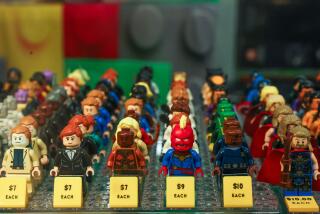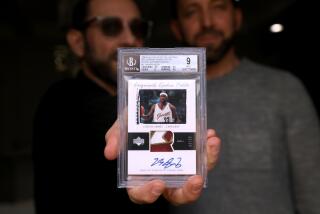Remember Those Comics Your Mom Tossed? Well. . .
- Share via
There is one overriding reason why prices are soaring for the nation’s most popular collectible.
When your mother had the chance, she made you throw it out.
The humble comic book, once damned by parents as toxic trash, is now bringing in serious cash.
“One of the common adages among collectors is ‘My mother made me throw them away,’ ” says Gary M. Carter, editor of the San Diego-based monthly the Comic Book Marketplace. “It just plants the seed so that as soon as they grow up they march back to mail-order houses and bookstores and put together the comics they were forced to get rid of. It has a tendency to keep comics rare because nobody kept them.”
Consider the scarcity--and estimated price--of a well-preserved Action Comics No. 1, one of the crown jewels of the massive collection of Dr. Jerry Buss valued at more than a quarter-million dollars. The L.A. Lakers owner’s 4,000-book trove, considered among the country’s top dozen comics collections, goes on the block next week at Sotheby’s in New York and is on view today in Beverly Hills.
Action No. 1 is considered the most important comic book ever published because it launched Superman and the age of superheroes. Buss’ copy, which cost a thin dime when it was published in June 1938, is now worth an estimated $40,000 to $50,000.
“It’s the kingpin book everybody wants,” says Jerry Weist, Sotheby’s comic books consultant. “When Superman appeared on the cover of that comic book, that changed history.”
Because of all the mom-engineered comic-trashing, the issue is considered fairly rare: Only 75 copies are known to exist. In comparison, stamps and coins may be considered scarce if there are 10,000 of them.
“What’s propelled the comic book market is you can’t produce the numbers to meet the demand,” Weist says. “If you had bought an unrestored copy of Detective Comics No. 27 in 1960 [which featured Batman’s debut], there’s no stock, no jewel, nothing you could have bought that would have made you more money or interest. Part of that [appeal] is irrational, but spending $3 million on a Jackson Pollock can also be irrational.”
Rather than drop millions on work from the New York School, some collectors invest in the Golden Age of comics from 1939 to 1946, Buss’ area of expertise. Comic books were novelties during the war years, and more were sold then than since, thanks in part to the visual void before the TV storm, Weist says. The optically attuned turned to pages and pages of Sunday cartoons.
“Kids today have TV, video games, computers,” he says. “There’s a lot of competition, and adults don’t read comic books today the way they did in the ‘40s.”
But some adults today read comic books the way they did when they were kids. Indeed, the 64-year-old Buss fell into collecting comics in 1987 to bring back his childhood in Wyoming and California.
“It’s a nostalgia thing,” says Buss, who has also collected stamps and coins. “You only got to movies once a week, so to fill in the rest of the week, which people now do with TV, comic books played a big role in your childhood.”
Buss’ collection, amassed largely through networking with dealers, is distinguished by its depth. “It’s not every day that someone says, ‘I’m going to give you Superman 1 to 100, Batman 1 to 100, Action 1 to 100,’ ” Weist says. “Never has anyone come to me with that kind of depth.”
Of course the No. 1s are regarded as particular beauties, such as Detective No. 1 of March 1937, which is estimated at $22,000 to $25,000. It’s the first comic book to have original stories unlike earlier books that reprinted newspaper strips.
Buss’ collection--which he says is on the block because he moved to a home with less storage space--follows superheroes up through the late ‘50s, dipping into the beginning of the Silver Age.
It’s fitting that Buss should hail from Southern California, the Western capital of the comics collectors world and home to the San Diego Comi-Con, the country’s largest comic book convention. It’s also ground zero for the 500-member American Assn. of Comic Book Collectors.
*
Carter estimates that half of the country’s most significant collections are held by Southern Californians--who usually opt for anonymity because comic books are very hard to insure.
“Because they’re paper, fire insurance is astronomical,” Carter says. “And it’s hard to explain to an insurance company why a comic book that initially cost a dime is worth several thousand dollars.”
Of course, the world of people who can drop thousands on a paper record of one’s memories is a rarefied one. And until the debut of comics auctions in 1991, the hunt for big game was largely restricted to “who you know and who got it first,” Carter says. Unlike Buss’, large collections are usually doled out piecemeal.
“The average guy doesn’t get an opportunity to buy or bid,” Carter says. “In a strange way, Sotheby’s and Christie’s and Butterfield & Butterfield have in a sense leveled the playing field for all collectors.”
And these days, their numbers have mushroomed from the few hundred of the mid-’60s to an estimated half a million serious collectors, Carter says. That’s because comics, once lambasted by PTAs, are finally being appreciated as a distinctively American art form.
“Jazz is indigenous to the United States,” Weist says. “The Japanese didn’t invent it. And comic books are indigenous to the United States. What’s happening is popular culture is taking its secondary place in American culture, and it’s becoming recognized and collected. So comic books have gone from being worth a few dollars to hundreds to thousands.”
More to Read
The biggest entertainment stories
Get our big stories about Hollywood, film, television, music, arts, culture and more right in your inbox as soon as they publish.
You may occasionally receive promotional content from the Los Angeles Times.










